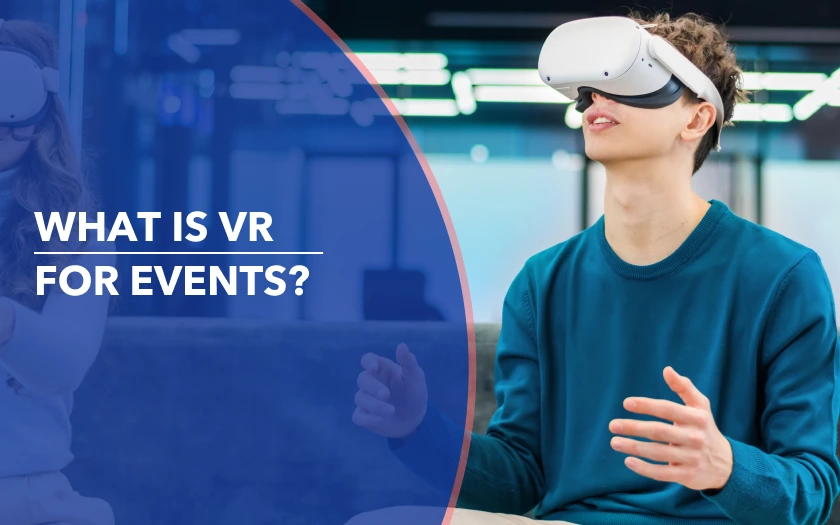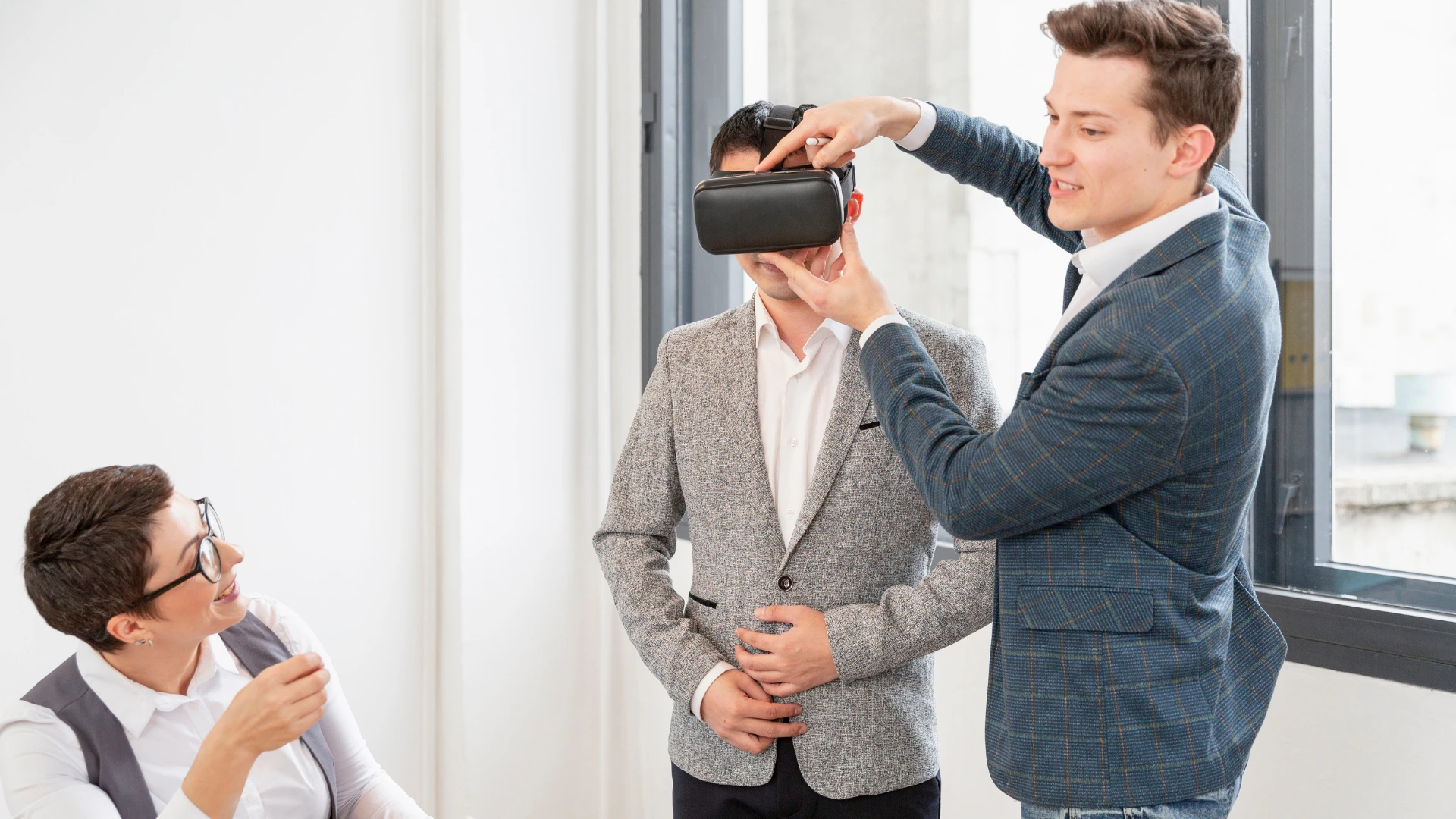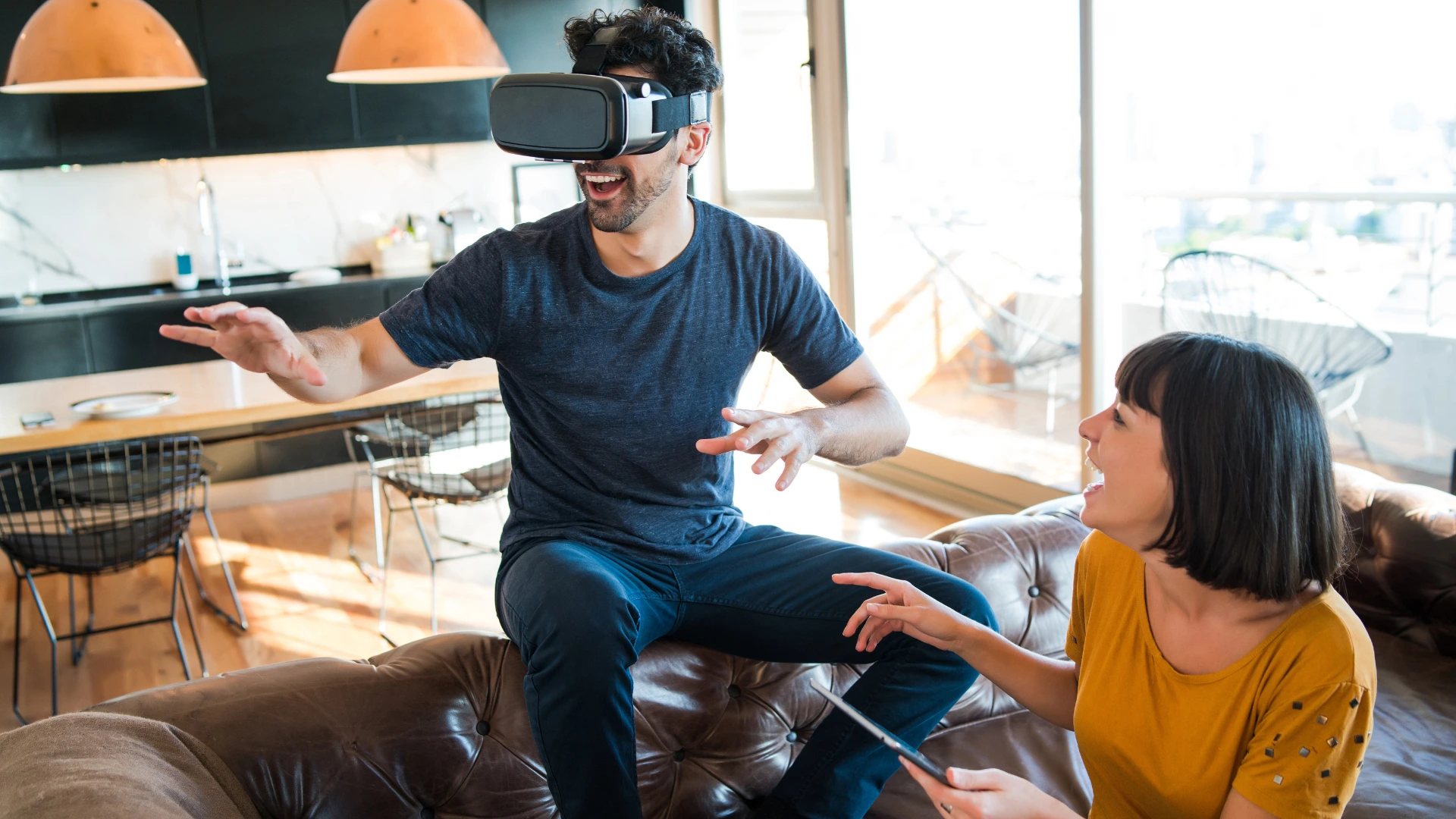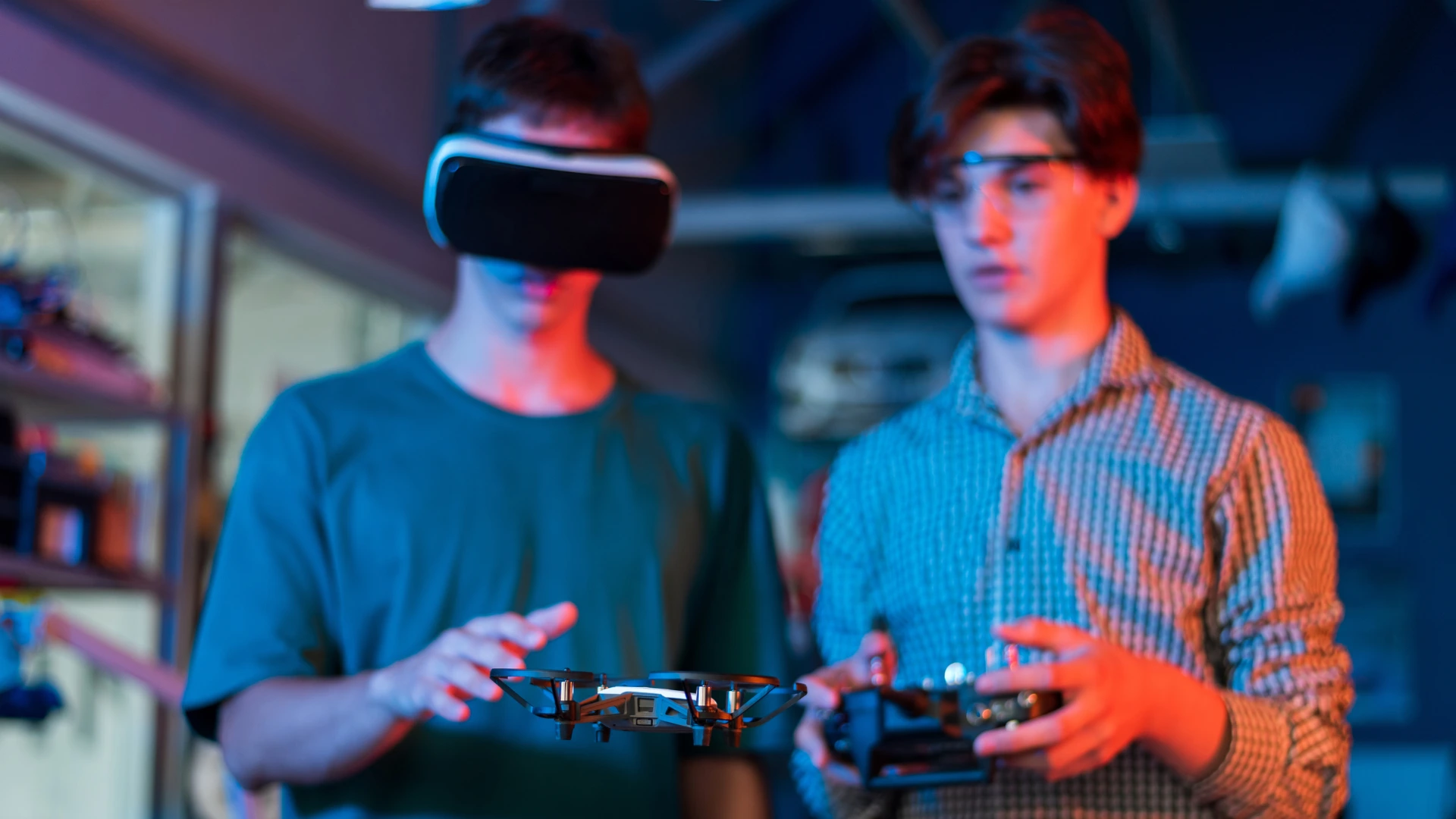What Is VR for Events in 2025? And Why Your Attendees Will Love It


Ever been to an event where you didn’t just watch, but felt like you were really there? Maybe you looked around, explored a booth, or bumped into someone (virtually) in the networking lounge. And for a moment, you forgot you were sitting in your home office… wearing slippers.
That’s the kind of immersive experience virtual reality (VR) is bringing to the event world—and it’s no longer just for gamers or sci-fi fans. VR has stepped out of the consumer-only niche and into the hands of forward-thinking organizers exploring immersive technologies to craft more engaging, unforgettable experiences. While VR adoption still requires overcoming some real-world hurdles, we’re seeing signs of VR picking up in new industries, like events.
So, what is VR for events, and why is it suddenly on every savvy event organizer’s radar in 2025? Let’s break down the potentials and practicalities of bringing VR into your event strategy.
{{table-of-contents}}
What Is VR for Events?

At its core, virtual reality (VR) is a technology that creates a fully immersive, computer-generated environment that you can explore and interact with. Typically, this is experienced by wearing a headset. However, VR can also be delivered through other devices like smartphones or computer screens, though with a less immersive effect. In this context, “immersive” means you're not just watching or observing from the outside; you're placed inside the experience. You can look around, move through the space, and interact with people or objects as if you're really there.
So, what is VR for events? It’s about using that same immersive tech to transform all—or more commonly, parts—of the event experience. Instead of passively watching a livestream or clicking through a basic event page, attendees can step into a digital venue that feels real, personal, and highly interactive.
Think of it like this: instead of scrolling through a flat agenda or watching a speaker on a 2D screen, your attendees could be walking through a virtual trade show, meeting other guests face-to-face (well, avatar-to-avatar), and exploring virtual booths in 3D space, all from wherever they are in the world. VR doesn’t have to power the entire event, it can also enhance smaller moments, like experiencing an immersive product demo through a VR headset at a trade show booth.
It’s also worth clearing up a few common misconceptions. VR is often confused with similar but distinct technologies:
- VR (Virtual Reality): A fully immersive experience where users enter a digital environment using a headset like the Meta Quest or Apple Vision Pro. They're not just viewing, they're inside the experience.
- AR (Augmented Reality): Rather than replacing your environment, AR adds digital elements to the real world, think Pokémon GO or those IKEA apps that let you "place" furniture in your living room using your phone.
- 360° Video / Virtual Tours: These are pre-recorded or panoramic experiences that let you look around a space using your mouse or phone screen. They’re cool, but not fully interactive like VR.
So when we ask, what is VR for events, we’re talking about giving attendees a sense of presence and freedom, where they can move, connect, and explore in ways that flat-screen formats alone just can’t replicate. And in 2025, that kind of immersion is starting to gain real traction. It’s no longer just a futuristic novelty, it’s becoming an exciting new way to engage audiences, even if it’s not quite mainstream yet.
Curious about how event pros are actually using VR today? We cover real-world examples, expert predictions, and future trends in the 2025 XR & AI in Events Report. It’s packed with insights, and worth checking out if you’re thinking of adding immersive tech to your next event.
Why VR Matters in 2025
Attendee expectations have changed, and not just for virtual events.
Back in 2020, when everything suddenly went online, just getting people onto a video call felt like a win. But as virtual events became the norm, attendees started wanting more: more interaction, more excitement, more experience. That shift pushed organizers to explore more immersive options—from spatial video tools to full VR setups—depending on their goals and tech readiness. As noted in the 2025 XR & AI Report for events, attendee expectations for emotional impact, interactivity, and presence are driving increased interest in XR solutions across the events industry.
Now, expectations have evolved again. It’s no longer just about being able to click around or join a chat, it’s about feeling like you’re truly part of the event, whether you’re there in person, watching remotely, or somewhere in between. People are craving connection, spontaneity, and moments that feel real.
That’s where VR comes in.
It’s not just about replicating a venue, it’s about unlocking experiences you can’t easily create in the real world. VR lets attendees step inside a product demo, take a virtual factory tour, or even walk through a humanitarian crisis simulation designed to evoke empathy. At events like CES, headset users explored a digital show floor where they could overhear live conversations and drop into breakout chats, transforming a passive watch party into a participatory experience.
Here’s why more event organizers are paying attention:
- Rapid Tech Adoption: According to the State of XR & AI in Events 2025 Report, the global XR market is projected to grow by 1,295% between 2024 and 2032, signaling major momentum for immersive tech.
- Expanding User Base: Over 171 million people are using VR worldwide today, and that number is rising as headsets become more affordable and user-friendly.
- Immersive Engagement: A Forrester survey shared via LinkedIn, notes that 68% of event professionals are actively exploring immersive tech to better engage remote audiences.
- Hybrid Is Mainstream: As hybrid events become the norm, attendees expect more than just a livestream, they want to feel present. VR helps close that gap.
And while not every event will require a headset, event organizers can still design immersive-feeling environments using spatial layouts, interactive content, and real-time engagement tools. It’s not about replacing in-person experiences, it’s about enhancing how attendees connect and participate, wherever they are.
How Event Organizers Are Using VR Today

You don’t need to build a full-on metaverse to start using VR. In fact, most event pros are using it in small, strategic ways to create those standout “wow” moments. Here’s a quick look at how it’s being done:
- Virtual Venue Tours: Perfect for sponsors or stakeholders who can’t visit in person. They can take a 3D walkthrough of the space and get a feel for the layout before showtime.
- Immersive Networking Spaces: Instead of clunky breakout rooms, attendees can move around as avatars in a virtual lobby or expo floor, and actually bump into people like they would IRL.
- Interactive Product Demos: Got something too big or technical to bring onsite? Let attendees explore it virtually, open panels, test features, and see it in action.
- VR Training Sessions: Great for onboarding or customer service workshops. It’s hands-on learning in a simulated environment that sticks way better than a slide deck.
- Immersive Entertainment: From branded selfie booths to VR-powered concerts or escape room games, this is where the “fun” lives, and it’s a big hit with sponsors and social shares.
Want to see how VR is being used in real-world events? We’ve compiled examples from event organizers across industries, check out our companion article on VR event case studies to see what’s working.
Benefits of VR for Events

You don’t need to be running a tech conference to get real value out of virtual reality. For event organizers, VR isn’t just a flashy trend, it’s a creative tool that can elevate key moments, unlock new experiences, and help you engage attendees in ways traditional formats just can’t.
Here’s what VR brings to the table for event professionals in 2025:
1. Creates Sensory-Rich, Memorable Experiences
Let’s be honest, most virtual events already come with engagement tools like live chat and polls. But, VR takes it further by placing attendees inside the action. It creates rich, multisensory environments that go beyond clicking and watching.
Whether it's walking through a branded installation, exploring a 3D product demo, or mingling in a virtual lounge, these moments feel novel and exciting. For many attendees, it’s still a new experience—which makes it more emotionally impactful. The result? Higher recall, deeper engagement, and better virtual event ROI for you and your sponsors.
2. Increases Engagement and Dwell Time
When attendees can move, explore, and interact freely, they naturally stay longer. VR keeps people curious – "Where can I go next?", "What happens if I click that?", "Can I talk to this person?"
That same sense of exploration is also present in immersive platforms like Remo, which allow attendees to navigate virtual spaces, move between tables, and join conversations naturally, no headset required. While it’s not virtual reality, it taps into similar dynamics that make immersive experiences feel more human and engaging.
That curiosity translates into:
- Longer session attendance
- Higher participation in activities
- More meaningful conversations between attendees and sponsors
And in a time when attention spans are shorter than ever, anything that keeps people genuinely engaged is worth its weight in gold.
3. Expands Accessibility to Global Audiences
Hosting a fully in-person experience often means excluding people due to travel costs, visas, time zones, or scheduling conflicts. VR doesn’t just make events accessible online, it makes them experiential at a distance.
With the right VR platform and headset, attendees from anywhere in the world can:
- Walk through a venue as if they’re physically there
- Interact with a product in 3D space
- Network with others through spatial audio and proximity-based conversations
- Participate in hands-on workshops or simulations
All without ever boarding a plane.
It’s the next step for inclusivity, offering remote attendees not just access, but presence. That emotional and spatial realism is something flat-screen experiences still struggle to deliver.
4. Unlocks New Data Insights
Traditional in-person events can tell you who showed up and when, but VR lets you see how people interact in the space.
- Where did they go?
- What did they look at the longest?
- Which booth had the most activity?
- Who did they talk to?
With heatmaps, interaction paths, and time-on-screen metrics, you can fine-tune future events based on what actually worked, rather than just guesswork or post-event surveys.
For event organizers, VR isn’t just about “cool tech.” It’s about creating deeper, more meaningful experiences, engaging remote audiences in new ways, and collecting smarter data. And as in-person, virtual, and hybrid events continue to evolve, using VR strategically can help your event stand out, especially when you want to deliver something memorable and impactful.
Challenges (and What to Watch Out For)
.webp)
As exciting as VR is, it’s not without its speed bumps, especially for event managers juggling tight budgets, hybrid audiences, or limited tech support. Adoption is growing fast, but let’s be honest: VR at events still isn’t fully turnkey. There’s a learning curve, real setup costs, and logistical hurdles to think through.
Here’s what to keep in mind:
1. High Cost of Headsets and Tech Setup
VR headsets like the Apple Vision Pro, Meta Quest 3, or HTC Vive XR Elite can cost anywhere from a few hundred to several thousand dollars each. That adds up fast, especially if you’re providing them for guests, staff, or multiple demo stations.
Tip: For broader accessibility, try headset-optional platforms like 8th Wall or use pre-recorded 360° video. Attendees can still enjoy immersive content right from their browser, no headset needed.
2. Limited Access for Some Attendees
Not everyone owns a VR headset, or a device powerful enough to handle 3D environments. This can limit participation or exclude key parts of your audience.
Tip: Offer layered access. Give VIPs the full VR experience and offer a 360° version for others. If it’s a core part of your event, consider distributing headsets to sponsors or priority guests.
3. Bandwidth and Hardware Requirements
VR experiences are data-heavy. You’ll need strong internet connections and reliable hardware, both for in-person deployments and remote attendees.
Tip: Test everything in real-world conditions before going live. Share a tech checklist with attendees so they’re not troubleshooting on the go.
4. Learning Curve for Both Organizers and Guests
Let’s face it, VR isn’t second nature for most people. Whether you’re organizing the event or attending it, chances are you’re not using VR daily. That unfamiliarity creates a steep learning curve on both sides. Organizers may struggle with setup, software compatibility, or even knowing what hardware to recommend. Guests, meanwhile, might not even know how to put on a headset properly, let alone navigate a virtual environment.
Tip: Offer optional pre-event onboarding sessions, or send out short, friendly walkthrough videos ahead of time. As Andy Fidel, Creative XR Producer & CEO of Spatial Networks, puts it: “You can’t expect someone who's new to VR to wear it for more than 15 minutes. But people who've used VR can easily last an hour or two.” A little upfront guidance goes a long way in making guests (and your team) feel more comfortable.
5. Headset Discomfort and Motion Sickness
VR isn’t for everyone. Some people experience dizziness or nausea, especially if the content involves fast movement or lag. But motion sickness isn’t the only challenge, headsets can be heavy, awkward, and isolating, making them uncomfortable to wear for long periods, particularly in public or group settings or if attendees are unfamiliar with them.
Tip: Stick to slower, more grounded experiences and test your content with a small, mixed group before scaling. Consider onboarding activities like avatar creation or short demos to help new users ease in.
6. Deployment Takes Time and Planning
This isn’t a drag-and-drop activation. Between hardware logistics, platform selection, user onboarding, and staff training, VR takes more prep than other fully mature event tech. If it’s your first time working with VR, you’re often better off partnering with an experienced XR and AI agency that can guide you through the process and handle the technical heavy lifting.
Tip: Start small. Pilot a single VR station or experience at your next event before scaling. See what resonates, and build from there.
Big picture? VR is gaining momentum, but it's not fully mature just yet. The payoff can be huge, but it takes careful planning to get it right. Start with what makes sense for your audience and your team, and grow from there.
What’s Next: The Future of VR in Events

2025 is a clear turning point: more event organizers are exploring VR not just as a novelty, but as a strategic tool. Adoption is growing, and while the technology itself develops gradually, its role in events is steadily expanding.
Still, experts caution that we’re not at mass adoption just yet. As highlighted in the XR & AI in Events 2025 Report, many believe we’re still in the early phases of adoption. While device availability is improving, widespread use, especially in events, could still be a few years away. Most estimates suggest it may take anywhere from two to ten years before immersive tech like VR and AR becomes truly mainstream.
Here’s some of the exciting current developments on the horizon:
- Headsets Are Getting Lighter and Smarter: Devices like the HTC Vive XR Elite and Pico 4 are becoming easier to wear, transport, and set up. That’s a game-changer for events that need quick deployment.
- AI-Generated VR Environments: AI tools are beginning to generate 3D spaces from simple prompts, potentially speeding up immersive content design. While still early, this could lower the barrier for organizers without a 3D design team.
- Facial Recognition & Emotion Tracking: Some experimental VR tools are starting to track facial expressions in real time to measure engagement. This opens doors for smarter feedback loops, but also raises questions around data privacy.
- Meta’s Social and Event Integration: Meta’s Quest 3 updates are pushing toward more natural collaboration in VR, with better avatars, shared environments, and event-ready features that aim to replicate the feel of networking IRL.
- More Affordable Models Are Coming: Apple is rumored to be developing a cheaper Vision Pro, which, if confirmed, could make premium VR hardware more realistic for larger-scale events.
TL;DR? The Future Is Flexible
VR in events is moving beyond novelty, it’s becoming more creative, customizable, and attendee-friendly. Whether it’s used for a standout keynote, a branded virtual world, or a single interactive booth, the future of event experiences is all about depth, not just reach.
Not ready to dive into full VR? Or maybe the budget, team support, or hardware just isn’t there yet? You can still create immersive, dynamic experiences with the tools you already have. Platforms like Remo offer spatial layouts and avatar-based interactions that give attendees freedom to move, mingle, and explore, no headset required. Book a quick demo to see how Remo brings virtual spaces to life.
And for a deeper dive into how VR, AR, and AI are shaping the event space in 2025 and beyond, don’t miss the new XR & AI Report for Event Organizers from Events.com, now available as a free download.
Frequently Asked Questions about Virtual Reality for Events
- What is a virtual reality event?
A virtual reality (VR) event uses 3D environments to simulate real or imagined spaces. Attendees can explore, interact, and network using a VR headset, often moving through the space as avatars and engaging with others in real time. Some platforms also offer limited access via desktop or mobile, though the full immersive experience typically requires a headset.
- What are some VR games for events?
VR games are interactive activities designed to engage attendees. Popular options include virtual escape rooms, scavenger hunts, trivia, and branded selfie booths. They’re great for team-building, icebreakers, or adding fun to your event.
- What types of VR experiences are available for events?
Common VR experiences include:
- 360° venue tours
- Avatar-based networking lounges
- Interactive product demos
- Hands-on training simulations
- Virtual entertainment like concerts or exhibits
These are typically designed for VR headsets, but some formats, like 360° video or WebXR demos, can also be made accessible via desktop or mobile, offering a lighter version of the experience.







.webp)




















